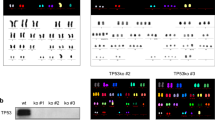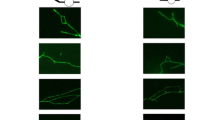Abstract
Bloom's syndrome (BS) and EM9 cells both display elevated frequencies of sister chromatid exchange (SCE) following growth for two rounds of DNA replication in bromodeoxyuridine (BrdU)-containing medium. To learn whether hyperresponsiveness to BrdU itself might play a role in causing the SCE elevation, the effects of BrdU on two other parameters, cellular proliferation and chromosome disruption, were examined, comparing the responses of BS and normal lymphoblastoid cells and of EM9 and CHO cells. BS and normal cells responded similarly with respect to growth for 4 days in BrdU-containing medium (0, 1, 3, and 5 μg/ml). Chromosome aberrrations were increased only slightly in the BS and normal cells after 2 days in BrdU. CHO cells responded to growth in BrdU-containing medium like BS and normal cells; however, little growth of EM9 was detected at any of the BrdU concentrations employed. CHO and EM9 cells also exhibited strikingly different amounts of chromosome damage following growth in BrdU. After 2 days in 1, 3, and 5 μg/ml BrdU 21%, 46%, and 50%, respectively, of the CHO cells had chromosome aberrations in contrast to 92%, 96%, and 98% of the EM9 cells. Most of the aberrations in the BrdU-treated CHO cells consisted of what appeared to be polycentric and ring chromosomes or chromosomes exhibiting telomere association. Acentric fragments were absent from most cells with polycentric and ring chromosomes, indicating either that the abnormal chromosomes were formed during an earlier cell cycle or that the abnormal chromosomes represent a form of association in which the telomeres are apposed so tightly that the juncture between chromosomes cannot be identified microscopically. EM9 cells treated with BrdU exhibited many chromatid and isochromatid gaps and breaks as well as numerous quadriradial, triradial, and complex interchange configurations. In addition, the types of aberrations present in CHO cells also were increased greatly in number. The different responses of BS and EM9 cells to growth in BrdU suggest that the molecular defects in the two cell types are different.
Similar content being viewed by others
References
Alhadeff B, Siniscalco M (1984) Complementation studies in murine/human hybrids suggest multiple etiology for increased rate of sister chromatid exchange in mammalian cells. In: Tice RR (ed) Sister chromatid exchange: Twenty-five years of experimental research. Brookhaven National Laboratory, Brookhaven (in press)
Chaganti RSK, Schonberg S, German J (1974) A manyfold increase in sister chromatid exchanges in Bloom's syndrome lymphocytes. Proc Natl Acad Sci USA 71:4508–4512
Dillehay LE, Thompson LH, Minkler JL, Carrano AV (1983) The relationship between sister-chromatid exchange and perturbations in DNA replication in mutant EM9 and normal CHO cells. Mutat Res 109:282–296
German J (1974) Bloom's syndrome. II. The prototype of human genetic disorders predisposing to chromosome instability and cancer. In: German J (ed) Chromosomes and cancer. J. Wiley and Sons, New York, p 601–617
German J, Schonberg S (1980) Bloom's syndrome. IX. Review of cytological and biochemical aspects. In: Gelboin HV, Mac-Mahon B, Mutsushima J, Sugimura T, Takayama S, Takebe H (eds) Genetic and environmental factors in experimental and human cancer. Japan Scientific Press, Tokyo, p 181–186
German J, Crippa LP, Bloom D (1974) Bloom's syndrome. III. Analysis of the chromosome aberration characteristic of this disorder. Chromosoma 48:361–366
German J, Schonberg S, Louie E, Chaganti RSK (1977) Bloom's syndrome. IV. Sister-chromatid exchanges in lymphocytes. Am J Hum Genet 29:248–255
Giannelli F, Benson PF, Pawsey SA, Polani PE (1977) Ultraviolet light sensitivity and delayed DNA-chain maturation in Bloom's syndrome fibroblasts. Nature 265:466–469
Hand R, German J (1975) A retarded rate of DNA chain growth in Bloom's syndrome. Proc Natl Acad Sci USA 72:758–762
Hand R, German J (1977) Bloom's syndrome: DNA replication in cultured fibroblasts and lymphocytes. Hum Genet 38:297–306
Henderson E, German J (1978) Development and characterization of lymphoblastoid cell lines (LCLs) from “chromosome breakage syndromes” and related genetic disorders. J Supramolec Struct Suppl 2:83
Henderson E, Miller G, Robinson J, Heston L (1977) Efficiency of transformation of lymphocytes by Epstein-Barr virus. Virology 76:152–163
Kao FT, Puck TT (1967) Genetics of somatic mammalian cells. IV. Properties of Chinese hamster cell mutants with respect to the requirement for proline. Genetics 55:513–524
Kapp LN (1982) DNA fork displacement rates in Bloom's syndrome fibroblasts. Biochim Biophys Acta 696:226–227
Krepinsky AB, Heddle JA, German J (1979) Sensitivity of Bloom's syndrome lymphocytes to ethyl methanesulfonate. Hum Genet 50:151–156
Latt SA (1973) Microfluorometric detection of deoxyribonucleic acid replication in human metaphase chromosomes. Proc Natl Acad Sci USA 70:3395–3399
Ockey CH (1979) Quantitative replicon analysis of DNA synthesis in cancer-prone conditions and the defects in Bloom's syndrome. J Cell Sci 40:125–144
O'Neill JP, Hartlein MW, Preston RJ (1983) Sister-chromatid exchanges and gene mutations are induced by the replication of 5-bromo- and 5-chloro-deoxyuridine substituted DNA. Mutat Res 109:259–270
Ray JH, Thompson LH, German J (1984) Bloom's syndrome and EM9 cell lines show similarly elevated SCE frequencies but different cell survivals in BrdU-containing medium. In Vitro 20:284
Shiraishi Y, Freeman AI, Sandberg AA (1976) Increased sister chromatid exchange in bone marrow and blood cells from Bloom's syndrome. Cytogenet Cell Genet 17:162–173
Shiraishi Y, Yosida TH, Sandberg AA (1982a) Analysis of single and twin sister chromatid exchanges in endoreduplicated normal and Bloom syndrome B-lymphoid cells. Chromosoma 87:1–8
Shiraishi Y, Yosida TH, Sandberg AA (1982b) Single and twin sister chromatid exchanges in endoreduplicated Bloom Syndrome cells. Proc Jpn Acad 58(B): 260–264
Shiraishi Y, Yosida TH, Sandberg AA (1983) Analyses of bromodeoxyuridine-associated sister chromatid exchanges (SCEs) in Bloom syndrome based on cell fusion: Single and twin SCEs in endoreduplication. Proc Natl Acad Sci USA 80:4369–4373
Thompson LH, Brookman KW, Dillehay LE, Carrano AV, Mazrimas JA, Mooney CL, Minkler JL (1982) A CHO-cell strain having hypersensitivity to mutagens, a defect in DNA strandbreak repair, and an extraordinary baseline frequency of sister chromatid exchange. Mutat Res 95:427–440
Vincent RA, Hays MD, Johnson RC (1978) Single-strand DNA breakage and repair in Bloom's syndrome cells. In: Hanawalt PC, Friedberg EC, Fox CF (eds) DNA repair mechanisms. Academic Press, New York, p 663–666
Author information
Authors and Affiliations
Rights and permissions
About this article
Cite this article
Ray, J.H., German, J. Bloom's syndrome and EM9 cells in BrdU-containing medium exhibit similarly elevated frequencies of sister chromatid exchange but dissimilar amounts of cellular proliferation and chromosome disruption. Chromosoma 90, 383–388 (1984). https://doi.org/10.1007/BF00294165
Received:
Issue Date:
DOI: https://doi.org/10.1007/BF00294165




